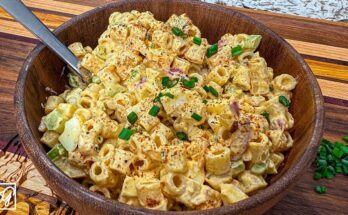Fig Preserves Recipe: Fig preserves are a delightful homemade treat that bring out the natural sweetness and rich, earthy flavors of fresh figs. Whether you’re spreading them on toast, using them in baked goods, or spooning them over cheese, these preserves offer a burst of flavor that captures the essence of summer in every bite. This traditional recipe has been passed down through generations, offering a touch of nostalgia and a whole lot of taste. Homemade fig preserves are a wonderful way to preserve the harvest and enjoy figs year-round.
Unlike store-bought versions, homemade fig preserves contain no artificial preservatives or excess sugars. They’re made simply with fresh fruit, sugar, and a touch of citrus, allowing the true fig flavor to shine through. Making your own also gives you control over the texture—whether you like your preserves chunky or smooth, thick or syrupy, the choice is yours.
Why Make Your Own Fig Preserves?
You might be wondering—why go through the trouble of making fig preserves at home when you can just grab a jar off the shelf? The answer is simple: flavor, purity, and customization. When you make your own preserves, you’re choosing ripe, quality figs. You’re controlling the amount of sugar. You’re avoiding artificial additives. And most importantly, you’re creating a recipe that reflects your taste.
There’s also something deeply satisfying about making preserves from scratch. It’s a way to connect with your food, to use what’s in season, and to create something you can share with friends and family. Plus, homemade preserves make fantastic gifts. With just a bit of effort, you end up with jars of golden sweetness that people will rave about.
Economically, it’s a smart move too. If you have a fig tree, or access to fresh figs in bulk, homemade preserves can help prevent waste and stretch your harvest much further.
What You Need – Ingredients & Tools
Fresh Ingredients
For the best preserves, you need the freshest figs. Choose ripe but firm figs—too soft and they may fall apart in cooking, too unripe and they’ll be bland. Here’s a basic ingredient list:
- 4 lbs fresh figs
- 6 cups granulated sugar
- 1 lemon, thinly sliced
- ½ cup water
Optional:
- A pinch of salt
- A splash of vanilla extract
- Spices like cinnamon or clove (for variation)
Essential Kitchen Tools
You’ll need a few basic tools for this recipe:
- Large, heavy-bottomed pot (non-reactive like stainless steel)
- Wooden spoon or silicone spatula
- Canning jars with lids
- Jar lifter or tongs
- Ladle and funnel (optional but helpful)
- Sterilization tools (boiling water or dishwasher)
- Clean kitchen towels
Having everything laid out before you begin makes the process smoother and more enjoyable.
Prepping Your Figs the Right Way
Cleaning and Sorting
Before cooking, it’s crucial to clean your figs properly. Rinse them under cool running water to remove any dirt or debris. Remove the stems and discard any figs that are mushy or show signs of mold. Organic figs are ideal since they haven’t been treated with pesticides—but always wash thoroughly regardless.
Sorting is equally important. If your figs are different sizes, consider slicing the larger ones in half so they cook evenly. You want consistency in size to ensure a uniform texture in your preserves.
Cutting and Pre-soaking
While you can preserve whole figs, cutting them in halves or quarters allows the sugar and lemon to penetrate better, enhancing flavor. Some traditional recipes also call for a pre-soak in sugar for several hours or overnight. This method draws out the natural juices and makes for a richer syrup during cooking.
To do this:
- Place cut figs in a large bowl.
- Sprinkle the sugar evenly.
- Add lemon slices.
- Let the mixture sit covered in the fridge for 4-12 hours.
This step isn’t mandatory, but it deepens the flavor and saves cooking time.
Step-by-Step Fig Preserves Recipe
Step 1 – Boil and Simmer
Pour the fig and sugar mixture into a large pot. Add ½ cup water and bring it to a gentle boil over medium heat. Stir frequently to prevent sticking or scorching. As it boils, the figs will release more liquid, and the sugar will dissolve into a fragrant syrup.
Keep the boil light—this isn’t the time for high heat. A slow simmer allows the flavors to meld without breaking down the figs completely. Foam may form on top; skim it off with a spoon to keep the preserves clear.
Step 2 – Add Sugar and Lemon
If you didn’t pre-soak your figs in sugar and lemon, now’s the time to add them. Gradually stir in the sugar while keeping the pot on low heat. The sugar will begin to dissolve, thickening the liquid around the figs. Add thin lemon slices (with seeds removed) to the pot. The lemon serves two purposes: it adds a subtle tartness that balances the sweetness, and its natural pectin helps thicken the preserves.
Let this mixture simmer for another 30-40 minutes. Stir occasionally to prevent sticking. As the preserves cook, the figs will soften and the syrup will start to thicken. Don’t rush this part—low and slow brings out the best texture and depth of flavor.
You’ll notice a transformation happening: the mixture becomes richer, more aromatic, and golden-brown in color. At this stage, you can add optional ingredients like vanilla or spices if desired.
Step 3 – Let It Rest Overnight
This is a classic trick used by many seasoned preserve makers. After simmering, turn off the heat and let the mixture sit, covered, overnight. This resting period helps the flavors mature and the syrup penetrate deeply into the fruit.
If you’re short on time, you can skip this step—but it’s highly recommended if you want luxurious, well-infused preserves. The figs absorb more syrup as they cool slowly, making them more flavorful and succulent. This also gives the preserves a nice consistency the next day.
Step 4 – Slow Cook to Perfection
The next day, bring your preserves back to a gentle simmer. Let them cook uncovered for 30-45 minutes or until the syrup thickens to your preferred consistency. A good way to test the syrup is the plate test: drop a bit onto a cold plate and let it sit for a minute. If it forms a gel-like texture and doesn’t run, it’s ready.
Be sure to stir frequently during this phase. The preserves can easily stick to the bottom of the pot if left unattended. You’ll know it’s done when the figs are glossy and tender, and the syrup clings to the spoon.
This is also the perfect time to tweak the flavor. Add a pinch of salt to balance the sweetness or a squeeze of extra lemon juice if you prefer more tartness.
Step 5 – Sterilize and Jar
While the preserves are cooking down, prepare your jars. Sterilizing is crucial—it prevents spoilage and extends shelf life. You can sterilize jars by boiling them in water for 10 minutes or running them through the dishwasher on the hottest cycle.
Once the preserves are done, use a ladle and funnel to pour the hot mixture into the warm, dry jars. Leave about ¼ inch of headspace at the top. Wipe the rims clean with a damp towel, place the lids on, and screw the bands fingertip-tight.
If you plan to store them for a long time, process the jars in a boiling water bath for 10 minutes. Otherwise, let them cool to room temperature and refrigerate.
Storage and Shelf Life of Homemade Fig Preserves
Homemade fig preserves can last up to a year when properly canned and stored in a cool, dark place. Once opened, keep them in the refrigerator and use within 2-3 weeks for the best flavor.
To maximize shelf life:
- Always use clean utensils when scooping preserves.
- Avoid double-dipping or contamination.
- Keep the jar sealed tightly after each use.
If you skipped the water bath canning process, the preserves should be refrigerated immediately and consumed within a month.
Tips for Best Flavor and Texture
- Choose fully ripe figs – They should be soft but not mushy. Overripe figs may disintegrate during cooking.
- Don’t skip the lemon – It adds brightness and acts as a natural preservative.
- Let them rest overnight – This makes all the difference in taste and consistency.
- Cook low and slow – Rushing the cooking process can lead to uneven texture or burnt syrup.
- Test the syrup – Use the plate test or thermometer (220°F) to check when it’s ready.
Texture is a matter of personal preference. Some people like whole or halved figs in their preserves, while others prefer them mashed. Feel free to customize.
Common Mistakes to Avoid
- Using unripe figs – These lack sweetness and flavor.
- Adding too much sugar early – Let the fruit cook down first before adding all the sugar.
- Not skimming foam – This can result in cloudy preserves.
- Improper jar sterilization – Can lead to spoilage or bacterial growth.
- Overcooking – This can make the figs too mushy or the syrup too thick.
How to Use Fig Preserves
As a Spread
The most common way to enjoy fig preserves is spreading them on toast, biscuits, or English muffins. They also pair wonderfully with peanut butter or cream cheese.
In Baking
Use fig preserves as a filling for thumbprint cookies, pastries, or even cakes. They add moisture and a deep, fruity flavor.
As a Topping
Spoon fig preserves over pancakes, waffles, or Greek yogurt. For a savory twist, serve them with cheese and crackers or on a charcuterie board.
Nutritional Value of Fig Preserves
Fig preserves don’t just taste great—they also offer a surprising number of nutritional benefits. While the sugar content is higher due to the preserving process, figs themselves are packed with nutrients. They’re rich in dietary fiber, antioxidants, and essential minerals such as potassium, calcium, magnesium, and iron.
Here’s a quick breakdown of what you might find in one tablespoon (approx. 20g) of homemade fig preserves:
| Nutrient | Amount |
|---|---|
| Calories | 50-60 |
| Carbohydrates | 13-15g |
| Sugars | 12-14g |
| Fiber | 1g |
| Vitamin A | 1% DV |
| Calcium | 2% DV |
| Iron | 2% DV |
Keep in mind, these numbers can vary depending on your recipe and serving size. While fig preserves aren’t exactly a low-calorie food, they are a better option than many processed jams and spreads, especially if you control the amount of sugar.
Fig Preserves vs. Fig Jam – What’s the Difference?
At a glance, fig preserves and fig jam might look and taste similar—but there’s a subtle yet important difference between the two.
Fig Preserves typically include larger pieces of fruit, often halved or whole figs suspended in syrup. The texture is chunkier, and the flavor is more natural, with a beautiful balance of sweet and tart. It’s perfect for those who love the taste of fruit and want that in every bite.
Fig Jam, on the other hand, is smoother and more spreadable. The fruit is usually mashed or pureed and cooked down further with sugar, sometimes pectin, resulting in a thicker, gel-like consistency.
If you’re aiming for a rustic, fruit-forward preserve, stick with preserves. If you want a smooth, uniform spread, jam might be your go-to.
Variations of Fig Preserves
Spiced Fig Preserves
Want to take your preserves up a notch? Add warming spices like cinnamon, nutmeg, or clove. These flavors pair beautifully with the natural sweetness of figs, making the preserves even more aromatic and comforting—especially during fall or winter.
Try this:
- ½ teaspoon cinnamon
- ¼ teaspoon clove
- A splash of vanilla extract
Add these in the final 15 minutes of cooking. They’ll infuse the syrup without overpowering the figs.
Honey Fig Preserves
For a more natural, earthy twist, replace some or all of the sugar with honey. Not only does honey bring additional depth of flavor, but it also has antimicrobial properties. Keep in mind, honey burns more easily than sugar, so cook at a slightly lower temperature and stir often.
Use a light floral honey for subtle sweetness or dark wildflower honey for a bold kick.
FAQs about Fig Preserves Recipe
1. Can I make fig preserves with dried figs?
Yes, but rehydrate them first by soaking in hot water for at least an hour. The texture and flavor will be different, but still delicious.
2. Do I need pectin to make fig preserves?
No. Figs naturally contain pectin, and lemon juice enhances it. No added pectin is necessary unless you want a very thick jam-like consistency.
3. Can I freeze fig preserves?
Absolutely! Just make sure they’re stored in airtight containers, leaving room for expansion. Use within 6-8 months.
4. How do I know if my preserves have gone bad?
Look for signs like mold, off smell, or bubbling. If in doubt, throw it out. Proper sterilization and sealing help prevent spoilage.
5. Can I reduce the sugar in this recipe?
Yes, but the sugar also acts as a preservative. If you reduce it significantly, be sure to store the preserves in the refrigerator and use them more quickly.
Conclusion
Homemade fig preserves are a rewarding, flavorful, and versatile addition to any pantry. With just a handful of ingredients and a bit of patience, you can transform fresh figs into a golden preserve that elevates breakfast, snacks, and desserts. Whether you enjoy them as a spread, a baking ingredient, or a gourmet topping, one thing is certain—they bring a taste of sunshine to any meal.
So go ahead, grab those ripe figs, and start preserving. Your future self will thank you every time you crack open a jar of your very own homemade fig preserves.



